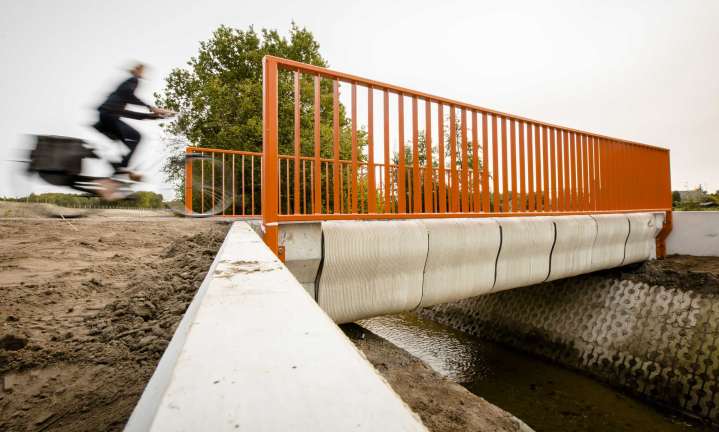
“The bridge is not very big, but it was rolled out by a printer, which makes it unique,” Theo Salet, from the Eindhoven University of Technology (where the bridge was printed), told Dutch broadcaster NOS. The 800 layers of the bridge took around three months to completely print out of the reinforced, pre-stressed concrete material; a far cry from the plastic that most of us are most accustomed to seeing extruded from these machines.
Stretching 8 meters (around 26 feet), the bridge is said to be “the first civil infrastructure project to be realized with 3D-concrete printing.” And while the structure is intended for cyclists, engineers tested the integrity of the bridge with a load of 5 tons, a much more significant weight than the bridge will ever carry. That said, the new structure is anticipated to see “hundreds of cyclists … every day.”
Outside of the novelty of being the world’s first 3D-printed concrete bridge, the project also has quite a few environmental advantages to traditional construction. As per the Eindhoven University of Technology’s website, “One of the main advantages of printing concrete is that much less concrete is needed than in the conventional technique, in which a mold (formwork) is filled with concrete.” On the other hand, the 3D-printing technique “deposits only the concrete where it is needed, which decreases the use of cement. This reduces CO2 emissions, as cement production has a very high carbon footprint.”
Furthermore, the university noted that a 3D-printer allows architects to design a bridge in almost any shape, and for construction workers to actually build the bridge at much faster rates. “No formwork structures have to be built and dismantled, and reinforcement mesh does not have to be put in place separately,” the university noted. “Overall, the researchers think the realization will eventually be roughly three times faster than conventional concrete techniques.”
Moving forward, there’s interest in designing and printing even larger structures. To do so, researchers anticipate needing to print separate pieces then assembling these individual components into their final form. So who knows — our imaginations just might be the limit when it comes to what 3D-printing can create.


